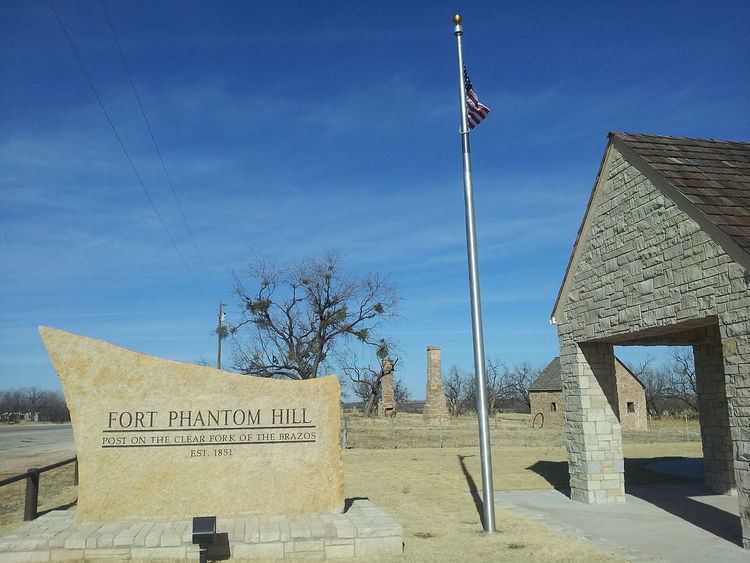Nearest city Abilene, Texas Address Abilene, TX 79601, USA Added to NRHP 14 September 1972 | NRHP Reference # 72001367 Area 8 ha | |
 | ||
Location Jones County, Texas, USA Similar Fort Belknap, Fort Chadbourne, Fort Griffin, Frontier Texas!, The Grace Museum | ||
Fort phantom hill investigation
Fort Phantom Hill was a United States Army and Confederate Army installation located at the Clear Fork of the Brazos River in Taylor County, Texas. The fort was active from 1852 to 1853 and again from 1856 until the 1890s.
Contents
- Fort phantom hill investigation
- Fort phantom hill abilene texas
- History
- Fort Phantom Hill Lake
- References
Fort phantom hill abilene texas
History
The post was established on November 14, 1851 by five companies of the 5th Infantry under Brevet Lt. Colonel John Joseph Abercrombieand just a year later was transformed into a well-organized and thoroughly developed post. Henry Hopkins Sibley assumed command on 24 Sept. 1853.
Conditions continued to be difficult for people at the fort, and in November 1853, approval was given for the military to abandon the fort. Shortly after the troops left on 6 April 1854, fire destroyed most of the log walls and thatch roofs of the buildings that made up this large and complex five-company post on the Texas Frontier. Several stone buildings, stone chimneys, and the stone building foundations remain intact today. A watercolor by J.B. Miller in the Center for American History in Austin, shows Fort Phantom Hill as it was before the fire.
In 1858, the property was reoccupied as a way station (No. 54) on the Southern Overland Mail route, Butterfield Stagecoach, at the abandoned fort until 1861.
Fort Phantom Hill was used again during the Civil War by the Confederacy's Frontier Battalion, and after the Civil War, in 1871, it became a sub-post of Fort Griffin (near Albany, Texas) during the Indian campaigns. Other forts in the frontier fort system, besides these two, were Forts Concho, Belknap, Chadbourne, Fort Stockton, Fort Davis, Fort Bliss, McKavett, Clark, Fort McIntosh, Fort Inge and Richardson in Texas, and Fort Sill in Oklahoma. There were "sub posts or intermediate stations" including Bothwick's Station on Salt Creek between Fort Richardson and Fort Belknap, Camp Wichita near Buffalo Springs between Fort Richardson and Red River Station, and Mountain Pass between Fort Concho and Fort Griffin.
After 1875, a town grew up around the ruins of Fort Phantom Hill. The location functioned first as a buying and shipping point for buffalo hides and eventually as a town of more than 500 residents. Census records in 1880 show more than 546 people living at the fort, which had a hotel and the staples of most West Texas towns.
Fort Phantom Hill also served briefly as the Jones County seat, although residents later moved it to the community of Anson. By the 1890s, Fort Phantom Hill was largely abandoned.
Modern day visitors to Fort Phantom Hill can still get a feel for what life must have been like here in the 1850s as people tried to tame the unforgiving West Texas landscape. It seems the wisdom of General Persifor F. Smith's choice of this site for what was originally known as "The Post on the Clear Fork of the Brazos River" was disputed from the very beginning, especially by Major John Joseph Abercrombie. The major was a West Point graduate who commanded the Post on the Clear Fork from the time of its establishment on, until April 27, 1852, according to A History of Fort Phantom Hill, The Post on the Clear Fork of the Brazos River, Jones County, Texas (prepared by Martha Doty Freeman in May 1999 for The Fort Phantom Foundation).
Lieutenant Clinton Lear, the post's quartermaster, even went so far as to assert that he could not imagine "that God ever intended white man to occupy such a barren waste" as was found at Phantom Hill.
The Fort Phantom Hill property has been owned by the family of Abilenian John Guitar since he purchased it in 1928. Mr. Guitar's grandson, Jim Alexander of Abilene, purchased the property in 1969. In 1997, Mr. Alexander deeded the property to the Fort Phantom Foundation to help assure its long-term preservation and to make it more accessible to the public.
Today Fort Phantom Hill is one of the most pristine historic sites in Texas. Besides the stone chimneys, other remnants of the developed fort remain for visitors to explore at the 22-acre (89,000 m2) site. These include an intact stone powder magazine, a stone guardhouse, and an almost-intact commissary or warehouse.
Fort Phantom Hill Lake
Fort Phantom Hill Lake (32°37′00″N 99°40′07″W) is located on Elm Creek in Jones County, 15 miles (24 km) in north Abilene.
Predominant Fish Species
